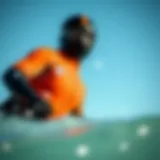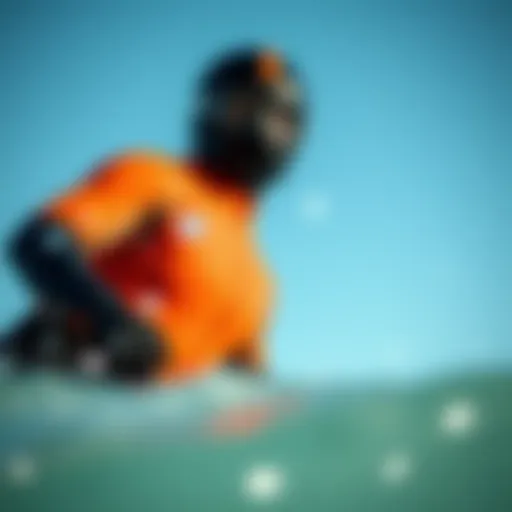Crosswing Kiteboarding: Trends, Techniques, and Insights
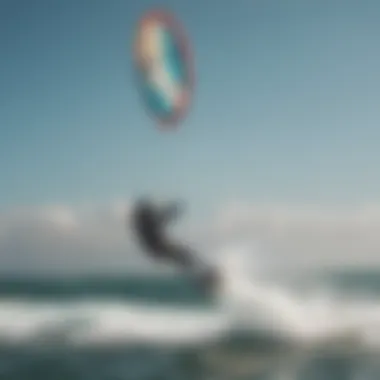

Intro
Diving into the realm of crosswing kiteboarding reveals much more than just a thrilling sport; it comprises a blend of skill, strategy, and community spirit. Recent developments in kiteboarding have sparked a wave of interest among both veterans and newcomers alike, as enthusiasts seek new techniques and gear that can elevate their experience on the water.
In this article, we aim to shed light on the latest trends, gear, and dynamics that characterizes this fascinating sport. Expect a deep examination of aspects from essential gear for beginners to advanced techniques practiced by seasoned kiteboarders. By understanding these facets, practitioners can not only enjoy themselves but also cultivate a safer atmosphere on the water.
Let’s embark on this exploration, where each wave brings new insights and every kiteboarder contributes to the evolving tapestry of this vibrant community.
Understanding Crosswing Kiteboarding
Crosswing kiteboarding represents a significant chapter in the evolution of kite sports. This section aims to dissect the many layers of crosswing kiteboarding, offering insights into its mechanics and cultural significance. Gaining a grasp of the fundamental aspects is essential for both newcomers and seasoned enthusiasts. Riding the wind with a crosswing broadens not just the range of maneuvers possible but also deepens one’s connection with nature.
The ability to navigate aerial dynamics and water waves enhances overall kiteboarding skills, making crosswing exploration more than just a pastime—it becomes an art form.
The Evolution of Kiteboarding
Kiteboarding, as many know it, birthed from a fusion of windsurfing and kitesurfing. It gained traction in the late 20th century, quickly becoming a fixture at beaches worldwide. But as interests grew, so did the innovation within the sport. The introduction of new technologies and designs allowed for smoother transitions between different styles, eventually paving the way for techniques like crosswinging.
In the past decade, riders began experimenting with wings that allowed for better control and agility. The dynamics shifted, with enthusiasts now favoring not only speed but also versatility. Most notably, the development of inflatable wings revolutionized the experience, blending performance and safety in a seamless manner. Today, it's not uncommon to see riders effortlessly gliding over the water, adapting to both calm conditions and choppy waves alike.
The Genesis of Crosswing Technique
The genesis of crosswing techniques is both intriguing and steeped in experimentation. Riders sought methods to harness the winds in a way that provided greater freedom and artistic expression while on the water. With the advent of lightweight materials and improved design methodologies, crosswinging allows individuals to jump higher and perform tricks that were previously deemed difficult or impossible.
This technique fuses elements from both surfing and wind sports, allowing for unique transitions that captivate audiences. As a result, learning these techniques provides not only a functional edge but also enhances the thrill of kiteboarding. The crosswing technique, rooted in creativity and adaptability, challenges riders to think outside the box and push the boundaries of what kiteboarding can be.
"In every gust, there lies a new opportunity for those willing to explore. The wind speaks a language of its own in crosswing kiteboarding."
Engaging with crosswing kiteboarding means embracing its philosophy—a conversation with nature, where the wind guides the ride. By understanding the evolution of the sport and appreciating its techniques, kiteboarders can enrich their experiences, dive deeper into the community, and develop a stronger connection to the environment around them.
Technical Aspects of Crosswing
Understanding the technical aspects of Crosswing kiteboarding is essential for any enthusiast wishing to master this exhilarating sport. By dissecting its various components—be it the intricacies of wing design or the way wind dynamics play a pivotal role—kiteboarders can enhance their skills and performance on the water. Each technical facet possesses unique benefits that can significantly affect riding experience, offer safety measures, and provide the necessary knowledge for adapting to various conditions.
Understanding Wing Design
Wing design is at the heart of effective Crosswing kiteboarding. This design isn't a mere aesthetic choice; it influences the wing's lift, stability, and overall handling. Modern wings are typically made from super lightweight materials that didn’t exist a couple of decades back. These materials enable kiteboarders to enjoy a seamless glide while reducing fatigue.
The shape of the wing also matters. A wide wingspan contributes to better lift and stability during flight. Riders often face a trade-off between speed and maneuverability; a wider wing can catch the wind efficiently but might feel bulkier during swoops or tricks. Considering this, a seasoned rider often tries several designs before settling on the one that suits their personal style.
Price can also sway your choice. A higher cost often means advanced technology used in the wing’s aerodynamic design, leading to improved performance. However, it’s equally valid to find an adequate budget wing that could serve novice or occasional users perfectly well without breaking the bank.
"Choosing the right wing design is akin to selecting the perfect shoe for hiking; comfort and fit are everything."
Harnessing Wind Dynamics
Wind dynamics are the unseen hand guiding every kiteboarder’s adventure. Understanding how to read the wind can drastically improve your experience. For starters, kiteboarders should pay attention to wind speed and direction. This knowledge helps in selecting the right wing and adjusting your stance on the board for optimum control. Wind can be fickle. A sudden gust may catch an unprepared rider off-guard, thus making knowledge of wind conditions essential to avoid mishaps.
Another aspect worth mentioning is turbulence. When kitesurfing near landscapes or structures, wind can behave erratically, creating turbulence. Knowing how to navigate these tricky patches is key. Experienced riders often use updrafts to gain height or navigate choppy waters effectively.
As kiteboarders, being aware of how your wing interacts with the wind not only conserves energy but also maximizes performance. Quick adjustments in stance or speed in response to wind shifts can be the difference between a smooth ride and a struggle against the elements.
Being attuned to these technical aspects can significantly boost one’s confidence on the water, leading to a more enjoyable kiteboarding experience overall.
Gear and Equipment Essentials
In the world of crosswing kiteboarding, the right gear and equipment can make all the difference, turning an average day on the water into an exhilarating adventure. Selecting the appropriate tools is not merely a matter of preference; it's about harnessing the wind, ensuring safety, and enhancing performance. With innovations in technology, the options available today are more varied than ever. Understanding what to look for can be the linchpin in your kiteboarding experience.
Choosing the Right Crosswing
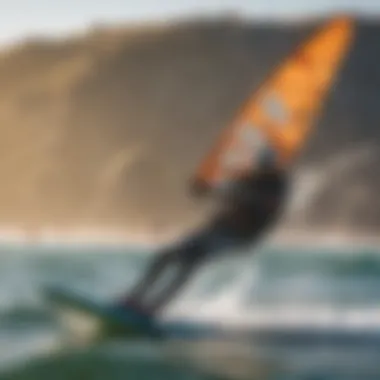

Choosing a crosswing is akin to picking the right partner for a dance; it’s all about compatibility with your style and skill level. Here are some crucial elements to consider:
- Size Matters: The general rule is that larger wings perform well in lighter winds, while smaller wings are better suited for stronger winds. Gauge your local wind conditions and your personal comfort.
- Material and Build Quality: Durable materials like ripstop nylon or double-layered fabrics can withstand the wear and tear of diverse environments. Check for production quality to ensure longevity.
- Design: Different designs cater to specific styles or conditions. For instance, a wing with a high aspect ratio offers speed and efficiency, whereas a low aspect ratio provides stability and lift.
Take a moment to visualize yourself gliding effortlessly over waves or cruising steadily along flat waters; your choice plays a pivotal role in making that vision a reality.
Safety Gear: A Necessity
Never underestimate the importance of proper safety gear in crosswing kiteboarding. It's not just about looking cool; it's about protecting yourself against the unpredictable elements. Here are some essentials:
- Harness: Select a comfort-fit harness that suits your body silhouette. A well-fitting harness distributes the load evenly, allowing for prolonged sessions without discomfort.
- Impact Vest: These vests provide extra cushion against unexpected falls or impacts, adding an extra layer of protection. It’s like putting on a seatbelt before a drive—an essential precaution.
- Helmet: A lightweight helmet can be your best buddy in windy conditions. It protects against head injuries while allowing for easy movements.
Investing in good safety equipment isn't just wise; it’s a way of respecting both the sport and yourself, ensuring you're ready to ride the wind with confidence.
Maintenance Best Practices
Taking care of your gear is crucial to prolonging its lifespan and maintaining optimal performance. Here are some best practices to keep your equipment in tip-top shape:
- Regular Inspections: Before every session, take a moment to inspect your gear. Look for any signs of wear on the wings, lines, and harnesses. Small tickets or frays can lead to bigger problems.
- Cleaning and Storing: After each use, rinse your wings and harness in fresh water. Saltwater and sand can cause major wear over time. Store them in a cool, shaded area—avoid leaving them in direct sunlight.
- Repair Leaks: If you notice your wing losing air quickly, identify the leaks and patch them up promptly. Ignoring these can lead to poor performance during your next ride.
Essential maintenance not only extends your gear's life but also enhances your overall safety and performance.
"Quality gear is an investment in your adventure; treat it right, and it will treat you right."
Navigating Different Conditions
Understanding how to navigate varying conditions is crucial for any kiteboarder looking to refine their skills. Conditions can change dramatically from one moment to the next, influenced by winds, water surface, and weather. Being adaptable in these situations not only improves performance but ensures safety as well. Every kiteboarder should be ready to read the environment and respond appropriately, whether one is approaching choppy waves or smooth flat waters.
Wave Riding Techniques
Wave riding is often seen as the pinnacle of kiteboarding. Unlike flat water where stability reigns, waves give a whole new challenge due to their movement and unpredictability. Here’s what you need to keep in mind:
- Reading the Waves: Before you even set sail, take a moment to observe the waves. Noticing patterns can help in identifying the best spots to ride. Is there a section that breaks consistently? That’s where you want to head.
- Timing Your Take-Off: Just like a surfer, timing is everything. Wait for the right moment when you can use the energy from a wave to propel yourself upwards. Don’t rush; a solid wave can make all the difference.
- Using the Right Stance: Keeping your body low helps maintain balance and control. Bend your knees and lean slightly forward; this position allows for better maneuvers when encountering sudden changes on the water.
- Finishing the Ride: As you descend, prepare your board for a smooth landing. Keeping your weight distributed evenly can help absorb the impact and maintain speed. Aim to ride the wave back towards the shore without losing control.
Mastering wave riding opens up endless opportunities to showcase skills, but remember to practice patience and build your confidence gradually.
Flat Water Tips
Flat water offers a different yet equally rewarding experience. While many kiteboarders may initially think flat conditions lack excitement, they indeed present a perfect environment for honing one’s technical abilities. Here are several strategies for navigating flat water:
- Perfecting Control: Flat surfaces allow for focused training on control and response. Utilize these conditions to practice your turns and transitions. Work on carving your turns smoothly without losing speed.
- Focus on Tricks: With minimal chop, experimenting with tricks becomes less daunting. Attempt jumps, spins, and other maneuvers that might be difficult in rougher conditions.
- Speed Management: Analyze how the wind effects speed on flat water. It’s easy to pick up pace; take your time to learn how to dial it back for better maneuverability.
By understanding the subtleties of flat water riding, one can significantly enhance technical prowess.
Remember: The conditions of the water are merely an invitation to explore your capabilities. Whether you're gliding over waves or skimming across flat water, adapting to your environment holds the key to unlocking the full potential of your kiteboarding journey.
Crosswing Techniques for Beginners
In the vibrant world of crosswing kiteboarding, the significance of mastering basic techniques cannot be overstated. Newcomers often find themselves juggling a flurry of information, but starting with a strong foundation is key. Even the most seasoned riders will tell you: getting the fundamentals right sets the stage for all future progress. Strong basic skills enhance not just your confidence but also your enjoyment on the water, which is always a game changer.
Fundamentals of Starting Off
When you first step into the realm of crosswing kiteboarding, understanding how to launch and initially control your wing is critical. Here are some essential components to consider:
- Wind Awareness: Knowing which direction the wind is blowing and adjusting your body position accordingly lays the groundwork for successful navigation on the water.
- Wing Inflation: Always inflate your wing properly. This may seem minor, but a fully inflated wing catches the wind efficiently, giving you more thrust.
- Positioning: Stand with your feet shoulder-width apart, keeping your knees slightly bent. This stance provides stability and control as you start riding.
- Launching: Pull the wing back and pull on the back lines. Take care to keep an eye on your surroundings. Safety first—no one wants to start off by accidentally mowing down a fellow enthusiast!
Once you’ve nailed these basics, the thrill of taking your first ride will be upon you.
Mastering Control and Balance
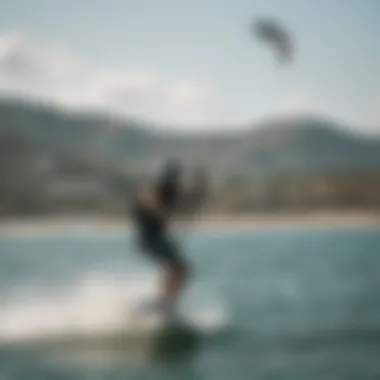

Balance is everything in crosswing kiteboarding, and it's a skill that takes practice to develop. Here’s where the rubber meets the road—getting the feel for how your body interacts with the kite and the water. Here are some essential tips to help guide you:
- Feet Placement: Once you’re towing, focus on keeping your feet aligned with the board. The more centered you are, the less likely you are to wipe out.
- Body Positioning: Leaning slightly forward helps distribute your weight, creating an efficient ride. Keep your arms relaxed and your elbows bent. A stiff posture won't get you anywhere fast.
- Responding to Changes: The wind can be a fickle friend. Learning to adjust your weight and balance according to shifting winds is crucial. Remember, anticipate rather than react; make subtle shifts to maintain control.
- Practice Makes Perfect: Engage in drills aimed at building your balance. Try riding over small waves or choppy water to find your footing. The more time you spend learning, the better you'll become.
"In the end, it’s the small adjustments that lead to mastery. Let your instinct guide you on the water."
By focusing on these techniques, beginners will not only feel more competent but also more comfortable as they dive deeper into the exciting world of crosswing kiteboarding. As with any discipline, patience goes a long way. So gear up, keep it safe, and enjoy the ride!
Advanced Crosswing Skills
Understanding advanced crosswing skills can make a world of difference for kiteboarders who are looking to elevate their game. It's about more than just mastering the basics; this stage of skill development opens the door to a whole new level of enjoyment and accomplishment on the water. For those willing to put in the time and effort, the mastery of these skills leads not only to improved performance but also to a deeper connection with the sport itself.
Through advanced maneuvers and techniques, you’ll discover how to push the limits of your kiteboarding experience. You become not just a participant but also an innovator in your approach. The benefits extend beyond personal satisfaction; they translate to greater safety in diverse conditions and more adaptability during unpredictable weather. Understanding complex movements and methods is key to ensuring that you can manage your kite and board effectively, which is crucial in challenging environments.
Furthermore, advanced skills can serve as a stepping stone to competitive participation. Engaging in competitions requires not only confidence but also technical proficiency. This section will give kiteboarders insights into what is necessary to get there.
Tricks and Maneuvers
When it comes to tricks and maneuvers, the line between artistry and athleticism is razor-thin. Mastering various tricks is essential for anyone looking to stand out on the water. These techniques can range from basic jumps to complex spins and are often categorized into several distinct styles:
- Air Tricks: This includes jump variations such as the kite loop or the handle pass. These moves typically require excellent timing and control.
- Ground Tricks: This involves riding close to the water surface and pulling off techniques such as the "bonking". It's not just about the jump; it’s about how you interact with the board and the water.
- Combination Moves: These are the spectacular sequences that combine several tricks, demanding high levels of coordination and balance.
Learning these tricks isn't just about fearlessness; it's also about carefully understanding wind direction, body positioning, and the behavior of your equipment in various situations. Practicing on flat water, for instance, allows you to focus solely on technique without the added challenge of waves, while riding in rough conditions can hones your adaptability.
"Precision and control are the names of the game; every trick has a learning curve, and patience will always pay off."
Transition Techniques
Transition techniques are often overlooked but are critically important in the realm of advanced kiteboarding. These skills determine how smoothly a rider can change direction or switch between maneuvers while maintaining speed and balance. Good transitions can make or break a run; this is especially true in competitive formats where judges are keen on fluency.
Transitions involve both your board and your kite, thus understanding the timing and sync between them is essential. Some key techniques are:
- The Surface Transition: This involves turning your board to change direction without losing speed, often minimizing your contact with the water.
- The Jump Transition: This is where you perform a jump and switch directions while airborne. It requires great timing, as you need to prepare for landing on the new edge.
- The Downwind Transition: This technique allows you to maintain momentum while turning downwind, often used in race scenarios.
Each technique will require its unique practice session, focusing on elements such as body weight distribution, kite position, and board angle. Mastery in these areas not only boosts confidence but also enriches the overall riding experience.
In summary, consolidating advanced skills and understanding these nuances in tricks, maneuvers, and transitions can elevate a kiteboarder's participation from casual to competitive, significantly enhancing both enjoyment and performance in the dynamic world of crosswing kiteboarding.
Community and Culture
The world of crosswing kiteboarding isn’t just about the equipment, techniques, or chasing the perfect wave; it also resides heavily in the community and culture surrounding the sport. The connections formed on the water and the camaraderie among enthusiasts play a crucial role in the overall experience. Here we explore how these social aspects enhance kiteboarding, from friendships made to skills shared, all while promoting a collective philosophy of safety and environmental responsibility.
Building Connections
Jumping into the crosswing community offers a chance to meet diverse individuals who share a common passion. From beginners and veterans to instructors and thrill-seekers, uniting over this dynamic sport fosters a welcoming environment. These connections often extend beyond the water, creating a network of support that can be invaluable for anyone looking to advance their skills or simply share experiences. When kiteboarders gather, they often share tips, tricks, and local knowledge, which enhances the overall skill set of all involved.
"The beauty of kiteboarding is not just in the thrill, but in the bonds we form with fellow enthusiasts."
Encouraging Inclusivity
The crosswing community prides itself on being inclusive. No one gets left on the shore regardless of skill level, age, or experience. Many communities host training sessions or meet-ups specifically designed for newcomers. This inclusive ethos means that everyone feels welcome to ask questions and seek guidance, making it simpler for beginners to transition into the sport. When people feel they belong, they’re more likely to engage deeply and progress.
Joining the Crosswing Community
Getting involved in the crosswing community can happen in various ways. Start by visiting local kiteboarding spots where you will generally find groups of riders sharing stories or gearing up for the day. Beyond just hitting the beach, you can also join local clubs or online forums where kiteboarders assemble both virtually and physically.
Here are some steps to help you get started:
- Find Local Clubs or Groups
- Participate in Group Activities
- Engage on Social Media
- Volunteer at Local Events
- Use platforms like Facebook or Reddit to search for local kiteboarding communities. Many places have dedicated pages that announce gatherings, lessons, or events.
- Attend meetups and workshops to not only enhance your skills but be part of an infectious atmosphere of learning. You will quickly discover that others are eager to share experiences.


- Follow crosswing kiteboarding pages and hashtags. Engage by commenting or sharing your journey; this often leads to connections with like-minded individuals.
- Many larger kiteboarding events welcome volunteers. Not only does this give you insider access, but it creates opportunities to meet pros and enthusiasts alike, fostering newfound friendships.
By embracing these steps, you can seamlessly integrate into the vibrant tapestry of the crosswing community, ensuring that your adventure is both exciting and enriching.
Events and Competitions
The buzz of competition adds yet another layer to the crosswing experience. Events and competitions serve as a platform for riders to showcase their skills while building camaraderie. Whether you’re a spectator or participant, these gatherings inspire thrill and motivate personal growth.
Types of Competitions
- Local Contests
These are often casual affairs and perfect for riders looking to step into competitive waters without the pressure of larger events. - Regional Tournaments
These contests generally attract a larger crowd and provide an opportunity to witness how fellow kiteboarders tackle challenging conditions. - National Championships
Top riders compete, often drawing players from various local communities. They set the bar high, pushing those who watch to sharpen their own skills.
Benefits of Participating in Events
- Skill Enhancement
Competing forces you to step up your game. It enables experimentation with new tricks or techniques under pressure, leading to personal growth. - Networking Opportunities
Engaging with other participants offers a chance to create lasting relationships, share understanding, and develop friendships that can extend beyond the event itself. - Community Spirit
The atmosphere generated at these events is palpable. Being part of a larger community, where everyone shares the same passion, stirs enthusiasm and a sense of belonging.
In summary, the community and culture surrounding crosswing kiteboarding significantly enriches the experience. Forming connections with fellow kiteboarders and engaging in events creates a supportive and inclusive environment that not only promotes skill development but also fosters a sense of belonging within this exhilarating sport.
Environmental Considerations
Understanding the environmental impact of kiteboarding, particularly crosswing, is essential for preserving the very ecosystems we cherish for our sport. As the popularity of this thrilling activity grows, so does the responsibility of practitioners to ensure they do not inadvertently cause harm to the natural world around them. This section looks closely at the implications of crosswing kiteboarding on ecosystems, as well as ways to foster sustainable practices within the community.
Impact of Kiteboarding on Ecosystems
When kiteboarding, whether on waves or flat water, the disturbance to the local environment can be substantial. It’s not just about the kites flying overhead; it encompasses the land and water interactions that happen below. For instance, in shallow waters, the churn of the board can upset seabed habitats, affecting marine life like fish and crustaceans.
Moreover, the noise generated by kites can also scare away wildlife. Birds and other coastal animals can be easily frightened, leading to disruption in their nesting and feeding habits. Certain areas, especially those rich in biodiversity, can suffer when kiteboarders frequent them without considering the delicate balance of the ecosystem.
- Key Effects of Kiteboarding:
- Disruption of seabed habitats.
- Disturbance to wildlife, particularly birds.
- Potential pollution from improper disposal of gear and waste.
Reflecting on these impacts, it's crucial for kiteboarders to choose their spots wisely and be mindful of local wildlife, especially during breeding seasons. By understanding how our activities influence the ecosystems we love, we can take meaningful steps to mitigate those effects.
Promoting Sustainable Practices
Adopting sustainable practices in crosswing kiteboarding is a no-brainer if we want to continue enjoying the sport for years to come. Here’s where individual riders can take action:
- Practice ‘Leave No Trace’ Principles:
Dispose of trash properly. Leave the environment cleaner than you found it. - Respect Wildlife:
Observe local wildlife and give them space. Stay away from sensitive areas, such as nesting sites for birds. - Opt for Eco-Friendly Gear:
Consider purchasing equipment from brands committed to sustainable practices. Materials and production methods can have a big impact on the environment. - Educate Others:
Spread awareness within the community. The more people know, the better decisions they can make.
“In every step we take on the water, there’s an opportunity to either nurture or neglect the world we ride in.”
By embracing these practices, kiteboarders are not just taking care of their immediate environment; they are also setting a precedent for future generations of enthusiasts. Looking ahead, it's clear that sustainability will play a pivotal role in the future of crosswing kiteboarding, influencing how we interact with nature while enjoying the sport.
The Future of Crosswing Kiteboarding
The horizon of crosswing kiteboarding is bright, teeming with possibilities that promise to revolutionize the way enthusiasts engage with the sport. As advances in technology and design continue to reshape the landscape, aspiring kiteboarders will have more opportunities than ever to elevate their skills and experiences. Understanding the future is essential not just for enjoyment but for safety, sustainability, and the overall growth of this captivating activity.
The potential for innovation holds notable significance. Imagine a future where wing designs adapt to individual rider preferences or where gear becomes increasingly lightweight yet durable. As materials and manufacturing techniques evolve, kiteboarding gear may cater to a broader audience. Moreover, this foresight helps riders stay ahead of the curve, ensuring they have the tools needed for both performance and protection in changing conditions.
Innovations in Gear and Technology
Innovation in technology is at the heart of any sport's evolution, and crosswing kiteboarding is no exception. The next few years promise an array of breakthroughs, particularly in gear design that could redefine the user experience.
- Adaptive Wing Designs: Future wings may feature adjustability, allowing riders to fine-tune their setups. This could mean altering curvature, size, or aspect ratio based on wind conditions or rider skill.
- Smart Gear Integration: Imagine wearing a harness equipped with sensors that monitor performance metrics like speed and altitude, transmitting data to a mobile device in real-time. Such advancements could elevate training by providing insights previously reserved for elite athletes.
- Expanded Eco-Friendly Options: As sustainability becomes central to outdoor sports, the emergence of eco-conscious gear is likely. Biodegradable materials and production methods that minimize waste could soon become standard.
- Enhanced Safety Features: Future gear is expected to incorporate advanced safety mechanisms, such as self-inflating flotation devices activated during adverse conditions. This would add an extra layer of security for riders venturing into challenging waters.
These innovations aim not just for performance enhancement but also for fostering a safer riding environment.
Predicted Trends in the Sport
As we look to the future, we can spot several trends that may shape crosswing kiteboarding. While some of these could seem like trends that have been previously explored, they are evolving, bringing with them fresh dimensions.
- Increased Accessibility: With greater emphasis on making kiteboarding accessible to all, we can expect more beginners' clinics and programs that cater to diverse demographics.
- Social Media Influence: Riding styles, community engagement, and access to tutorials will thrive on platforms like Instagram and TikTok, creating a culture that's visually driven and highly connected.
- Championship Expansion: Competitive events could gain recognition as more riders join the sport, leading to local, national, and international competitions that promote talent and community spirit.
- Remote Locations: As kiteboarders seek solitude away from popular destinations, more will explore lesser-known locales, emphasizing exploration and sustainability in their adventures.
These trends not only signal growth within the sport but also reflect a community eager to embrace change. By adaptating to innovations and trends, crosswing kiteboarding is set to flourish, fostering a richer culture of respect for the environment, creativity, and camaraderie.
